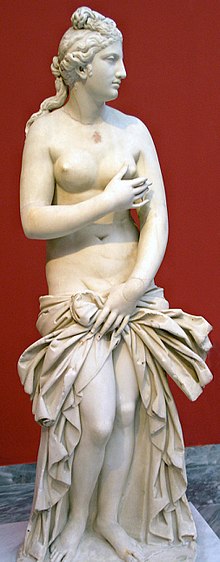Cypris
| Aphrodite | |
|---|---|
| Goddess of love, beauty and sexuality | |

Aphrodite Pudica (Roman copy of 2nd century AD), National Archaeological Museum, Athens
|
|
| Abode | Mount Olympus |
| Symbol | Dolphin, Rose, Scallop Shell, Myrtle, Dove, Sparrow, Girdle, Mirror, and Swan |
| Personal Information | |
| Consort | Hephaestus, Ares, Poseidon, Hermes, Dionysus, Adonis, and Anchises |
| Children | Eros,Phobos, Deimos, Harmonia, Pothos, Anteros, Himeros, Hermaphroditus, Rhodos, Eryx, Peitho, Eunomia, The Graces, Priapus, Aeneas |
| Parents | Uranus or Zeus and Dione |
| Siblings | Aeacus, Angelos, Apollo, Ares, Artemis, Athena, Dionysus, Eileithyia, Enyo, Eris, Ersa, Hebe, Helen of Troy, Hephaestus, Heracles, Hermes, Minos, Pandia, Persephone, Perseus, Rhadamanthus, the Graces, the Horae, the Litae, the Muses, the Moirai, or the Titans, the Cyclopes, the Meliae, the Erinyes (Furies), the Giants, the Hekatonkheires |
| Roman equivalent | Venus |
Aphrodite (/æfrəˈdaɪti/ (![]() listen) af-rə-DY-tee; Greek: Ἀφροδίτη Aphrodite) is the Greek goddess of love, beauty, pleasure, and procreation. She is identified with the planet Venus; her Roman equivalent is the goddess Venus. Myrtle, roses, doves, sparrows and swans are sacred to her.
listen) af-rə-DY-tee; Greek: Ἀφροδίτη Aphrodite) is the Greek goddess of love, beauty, pleasure, and procreation. She is identified with the planet Venus; her Roman equivalent is the goddess Venus. Myrtle, roses, doves, sparrows and swans are sacred to her.
In Hesiod's Theogony, Aphrodite was created from the sea foam (aphros) produced by Uranus's genitals, which had been severed by Cronus. In Homer's Iliad, however, she is the daughter of Zeus and Dione. In Plato (Symposium, 180e), these two origins are said to be of hitherto separate entities: Aphrodite Ourania (a transcendent, "Heavenly" Aphrodite) and Aphrodite Pandemos (Aphrodite common to "all the people"). She had many other names, each emphasizing a different aspect of the same goddess, or used by a different local cult. Thus she was also known as Cytherea (Lady of Cythera) and Cypris (Lady of Cyprus), both of which claimed to be her place of birth.
...
Wikipedia
